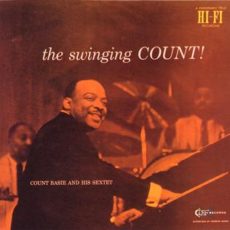
Daily Dose Of Jazz…
William James “Count” Basie was born on August 21, 1904 in Red Bank, New Jersey. His father played the mellophone, his mother played the piano and gave him his first piano lessons. Taking in laundry and baking cakes for sale for a living, she paid 25 cents a lesson for his piano instruction. The best student in school, he inished junior high school and spent much of his time at Red Bank’s Palace Theater, where he quickly learned to improvise music appropriate to the acts and the silent movies.
A natural pianist but preferring drums he was discouraged by the obvious talents of Sonny Greer, who also lived in Red Bank and became Duke Ellington’s drummer in 1919, He let the idea of drumming go and concentrated on the piano exclusively at age 15. He and Greer played together in venues until Greer set out on his professional career. By then, Basie was playing with pick-up groups for dances, resorts, and amateur shows, and Harry Richardson’s Kings of Syncopation.
By 1920 Basie was in Harlem where he bumped nto Greer and started meeting the musicians making the scene like Willie “The Lion” Smith and James P. Johnson. Before he was 20 years old, he toured extensively on the Keith and TOBA vaudeville circuits as a solo pianist, accompanist, and music director for blues singers, dancers, and comedians. This provided an early training that was to prove significant in his later career.
Back in Harlem in 1925, he met Fats Waller, who taught him how to play that instrument. As he did with Duke Ellington, Willie “the Lion” Smith helped Basie out during the lean times by arranging gigs at house-rent parties, introducing him to other leading musicians, and teaching him some piano technique.
In 1928, Basie joined Walter Page and his Famous Blue Devils. It was at this time that he picked up the moniker of Count. The next year saw him in Kansas City holding down the piano chair with Bennie Moten. After a couple of re-organizations of the band, Basie formed his own nine-piece band, Barons of Rhythm who played regularly at the Reno Club and on the radio. Moving to Chicago, Illinois the band eventually became the Count Basie Orchestra where they did their first recordings for Vocalion under the name Jones-Smith, as Basie had already signed with Decca.
Over the course of the fifty years he led the band he was instrumental in creating innovations like the use of two “split” tenor saxophones, emphasizing the rhythm section, riffing with a big band, using arrangers to broaden their sound, which any other bands copied. He also brought to prominence such players as Lester Young, Herschel Evans, Freddie Green, Buck Clayton, Harry “Sweets” Edison, Al Grey, Jimmy Rushing, Helen Humes, Thelma Carpenter, and Joe Williams.
Pianist, organist, bandleader, and composer Count Basie, who recorded close to two hundred albums and in 1958 became the first Black man to win a Grammy Award, passed away on April 26, 1984.
More Posts: bandleader,composer,instrumental,music,organ,piano


